Reviews
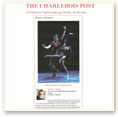
“I have never seen anything quite like Aparna Sindhoor’s company, Navarasa Dance Theatre, in action. There is not only a fusing of dance and theatre,here, but even within the different arts an explosive fusion of cultures.The dance is definitely rooted in the traditional, but they have incorporated into the movement elements from occidental modern dance (thereis a stunning pas de deux that would be at home with Alvin Ailey’s company) and even more eclectic suggestions than that.”
Gaëtan L. Charlebois’s review of ENCOUNTER performance in Montreal, May 2011
Encounter by the Navarasa Dance Theater based in Boston, created by Artistic Director Aparna Sindhoor and Anil Natyaveda was superb for its high quality performance and for its evocative rendition of a Mahasweta Devi’s short story.
Narthaki, Los Angeles, June 2011.
Most moving was “Encounter,” a theatrical piece by Aparna Sindhoor, artistic director of Navarasa Dance Theater, who performed with four male dancers.
Portland Press Herald, Bates Dance Festival, August 2011.
“Encounter with Self” captured viewers with a sensual exploration of mental and physical identity, juxtaposing slow, calculated gestures with quick, impulsive movements to create a contemplative dynamic between them.
Justice, Brandeis Residency, October 2011.
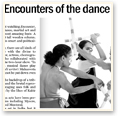
It is quite possible to come out watching
Encounter, a curious mixture of songs,dance,martial art and drama,admiring one of its most amazing feats:A dance up and down a 10-foot tall wooden column.But there is much more to this smart and politicaly alive production.
India Abroad, December 2010.
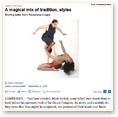
“Collaboratively created by Sindhoor and Natyaveda, Navarasa’s choreography is grounded in traditional Indian dance, but reaches outward. They incorporate modern dance, Indian martial arts, aerial dance, Bollywood’s pop influences — all with an eye for originality and a skillful use of space,sending dancers into eye-catching floor patterns. Embedded are compelling dances: an acrobatic solo up and down a roughly 10-foot-tall wooden column,a sensuous, serpentine duet, a fighting dance with the clash of wooden canes. The most engaging dances are the rhythmic group dances, slaps,and claps complementing the stomps of ultra-flexed feet and high kicks that smack against; outstretched hands.”
Boston Globe, Sep, 2010
The stage was vibrant with youth,energy,colour and celebration. Aparna Sindhoor and her troupe of bare-chested, mundu-clad young men were performing at Amol Palekar’s theatre festival at the Yashwantrao Chavan Auditorium on Friday.
Pune Mirror, December 2008
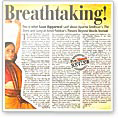
Breathtaking!A performance deeply, almost in-your-face Indian, but impressively international in its appeal and quality…. The level of individual skill was high, and the combination created an experience that stunned the audience with its complexity and beauty…”.
Times of India, Dec 2008
It is only an artiste performance that can speak a thousnad words without saying a single one. The fact was proven again as pantomime Irshad Panjatan and artistic director Aparna Sindhoor performed at Amol Palekar’s theatre festival.
The Indian Express, Pune Newsline, December 2008.
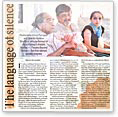
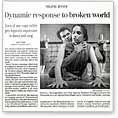
“the duets between Sindhoor and Anil Natyaveda are riveting. Possessed of a haunting singing voice in addition to her other talents, Sindhoor is truly a wonder”.
Montreal Mirror, Oct 2007
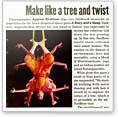
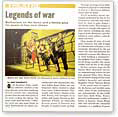
Sindhoor’s choreography … grounds her work in the form’s [Bharatanatyam] basic vocabulary and style – But she also embraces Indian martial arts, yoga moves, theatrical gesture, and a modern dancer’s eye for space to create dances that seem both old and new. Fanciful folk tales and tantalizing aerial feats.Two dynamic and athletic male dancers, Anil Natyaveda and Pratheesh Sivanandan, portray a variety of characters.
Boston Globe, Jul, 2007
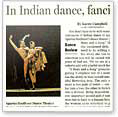
While her [Aparna Sindhoor] production is sure to cause controversy among traditionalists of Bharatnatyam, she pushes the boundaries in a way that allows expansion of the art form without deserting it altogether. Aparna Sindhoor Dance Production, A Story And A Song Captivates.
Lokvani, Jul 2007
…Aparna Sindhoor’s choreography is honest and exquisite.
Le Soleil (one of the leading French news papers in Quebec City), Sep 2005
…performance of singer, dancer Aparna Sindhoor was seductive.
VOIR (French Magazine), Sep 2005.
Aparna Sindhoor gave life to the tragedy inherent in the poetry of war and killing and the destitution of women…. To a poem she has sung herself, to no other musical accompaniment except a guitar she danced to simple pada jatis and underplayed abhinaya, a contradiction she accomplishes so well.
The Hindu, Jan 2004.
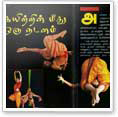
Kumudham (a major tamil weekly), December 2007 – Article and Interview
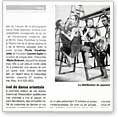
Montreal Newspaper
River Rites was an effective combination of [Sindhoor’s] talents and creativity…It was very powerful. She told the story of the struggle of Adivasi people very effectively.
India New England, Mar 2004.
Aparna Sindhoor’s performances express a deep patience and commitment to art and life and works with tradition and individual talent/creativity.
Andholana, Dec 2003.
Choreographers often bring their passions and outrages to the stage. Aparna Sindhoor takes it a step further- she brings the stage to others…
MS. Magazine June/July 2001.
What sets apart Aparna is her hand picking Kannada poetry and short stories from various parts of the world, set them to dance and present them in a very innovative and bold fashion as to make them come alive on stage. The impact they leave on the minds of the audience is deep.
Shruti, Apr 2001.
Flexible Bharatanatyam dancer Aparna Sindhoor dances sinuously in a traditionally classical style of her native India. Her sprightly choreography, by contrast, conveys boldly dramatic stories bolstering progressive views on contemporary issues.
Bay State Banner, MA, 2000.
Using spoken word enriched by the idiom of Bharatanatyam dance movements, and live Ghatam played by her mother over a taped music soundtrack, Aparna Sindhoor uttered a fevered cry for the release of death row journalist, Mumia Abu Jamal. At that point, had she the stunned audience to follow her to the penitentiary where Mumia is incarcerated, many would have gladly heeded the call.
News India, New York, 1999
She (Aparna Sindhoor) is hauntingly effective.
Daily Hampshire Gazette, MA, 1997.
The entire display was very moving, highly elevating and evocative. Aparna’s quick movements, mercurial expressions and dignified suggestions lent this (‘The Incident And after’) show great charm. The flexibility of Bharatanatyam was ably displayed by Aparna by choreographing successfully a theme strictly not within the classical frame.
The Hindu, Dec 5th 1997.
In the dance “Kozhalanudhida” (He played the flute) she (Aparna) played the flute of our heart.
Kannada Prabha, Feb. 1996.
In “Chilimili Endo Duva Giligalira” and “Akka Kelavva Nanonda Kanasa Kande” (immortalized by Mallikarjun Mansoor), music, meaning, dance and expression attained a very high degree of creativity.
The Hindu, Sep. 1996.
Aparna performed this number with great dignity in keeping with the solemnity of such transcendental love… The choreography was crisp, the jatis short and tidy. The dance simple and elegant.
Indian and World Arts and Crafts, June 1995.
If according to Bharata’s Natya Sastra the evocation of proper sentiments in the refined assemblage is the true test of a good performance, Aparna’s portrayal in “Putta Vidhave” (young widow, by the great Kannada poet Dr. D. R. Bendre) passed the acid test.
Sruti, May 1995.
Aparna sings poetry through her body. Poetry gets new light through her dance features.
Udaya Vani, May 1995.
Aparna Sindhoor of Mysore herself a professional and a guru, presented Jayadevakavi’s Ashtapadi in a new light rich in emotion and verve.
The Hindu, Oct. 28, 1994.
In varna (Manavi) she sought to convey her grasp over the medium. All the three Kannada compositions (saddu madali, yaava mohana, akka kelavva) were evocative with impressive abhinaya.
Deccan Herald, Sep 1993.
Aparna Sindhoor does not just dance. She becomes one with the stage.
Mysore Mitra, June 1993.
Jatiswara and Padavarna came out very well. Javali and Ashtapadi reflected the talent and dedication of Aparna.
Praja Vani, Feb 1989.
